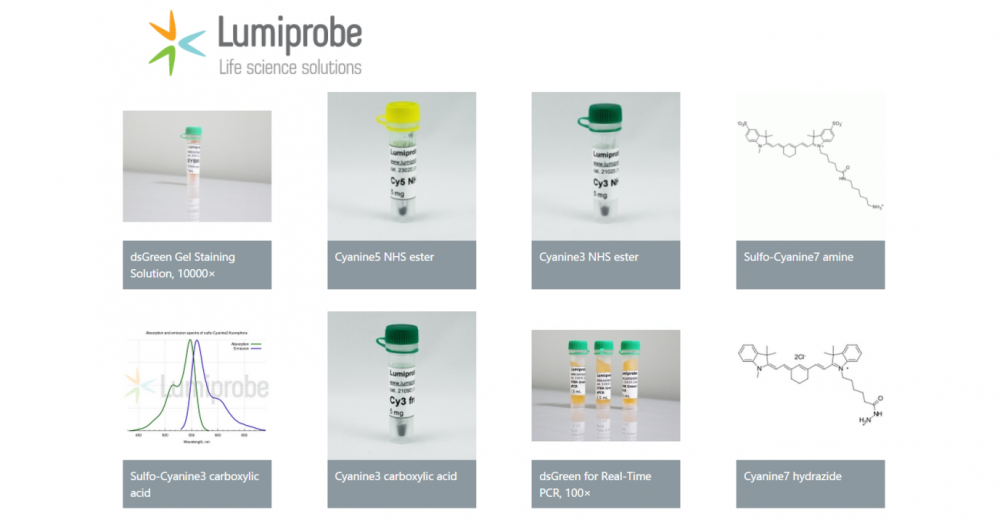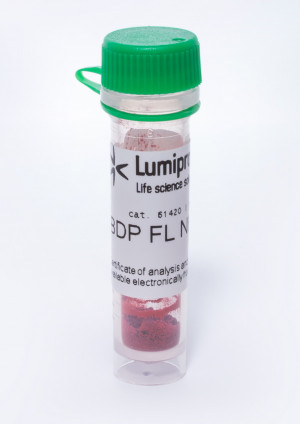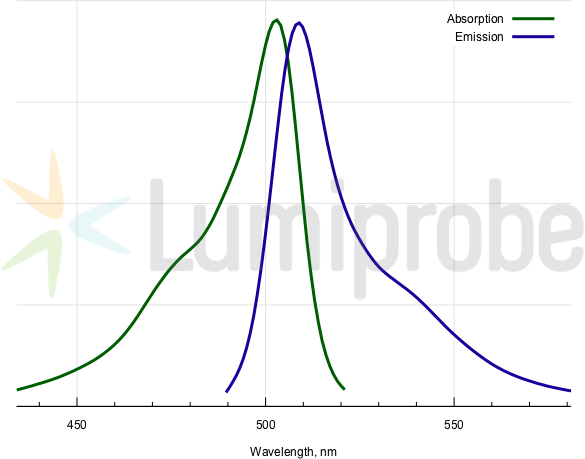Cy3/5/7 NHS ester和带NH2多肽和抗体连接实验方法及步骤
Cy3 NHS ester, Cyanine5 NHS ester和Cyanine7 NHS ester可以标记含有amine的多肽,抗体,蛋白,DNA和寡核苷酸及其他小分子。在反应条件下NHS可以和NH2发生反应,从而连接到一起。
(一):Cyanine5 NHS ester和多克隆抗体的连接实验方法和步骤
【准备材料】:
Cy3 NHS ester purchased from xi an ruixibio
anti-GST多克隆抗体purchased from Abcam
【实验步骤】:
1. 在1 L 0.15 M NaCl 溶液中透析anti-GST抗体(浓度为 0.5 mL at3 mg/mL),常温透析4小时。
2. 在4°C用新鲜的1 L 0.15 M NaCl 溶液再透析过夜。
3. 第二天用1 L 0.1 M NaHCO3 (pH 8.3)透析4小时。
4. 用0.22 μm注射器过滤头过滤抗体溶液。
5. 用0.1 M NaHCO3 稀释少量的抗体,在280nm处测其紫外吸收值计算标记抗体的总量 (IgG antibody摩尔吸光系数170 000 M-1 cm-1 at 280 nm).
6. 用DMSO配置Cy3 NHS (MW 616.19)溶液浓度为10 mg/mL;计算所需体积以得到想要的Cy3NHS 和抗体的比值(例如20:1),然后慢慢将其加入到抗体溶液中,同时在暗处常温缓慢搅拌45分钟。
7. 用1 L 0.15 M NaCl 溶液常温避光透析4小时除去未标记上的Cy5。
8. 在4°C用新鲜的1 L 0.15 M NaCl 溶液再避光透析过夜。
9. 用1 L of 0.01 M PBS/ 0.01% 叠氮化钠溶液常温避光透析4小时, 在4°C常温避光再次透析过夜。
10. 用0.22 μm注射器过滤头过滤抗体溶液。
11. 用0.01 M PBS/0.01 % 叠氮化钠整数倍稀释标记抗体溶液,测量280nm(蛋白)和552nm(Cy)处的紫外可见吸光度。
12. 产品冷冻干燥成粉末或在0.01 M PBS/ 0.01% 叠氮化钠溶液中,-20℃避光储存。
F/P计算:
Cy3在552nm摩尔吸光系数为150 000M-1 cm-1;此蛋白在280nm的摩尔吸光系数为170 000 M-1 cm-1;
不同蛋白的摩尔吸光系数不一样;.Cy3染料本身在280 nm 的吸收是552nm处的8%。按以下公式计算F/P
值。
[Cy3] = A552/150000
[antibody] = {A280 – (0.08×A552)}/170000
F/P final= [Cy3]/[antibody]= {1.13×A552}/{A280 – (0.08×A552)}
(二):Cyanine5 NHS ester和标记 (D-ser2)-leucineenkephalin的连接实验方法和步骤
【准备材料】:
Cy5 NHS ester purchased from xi an ruixibio
(D-ser2)-leucineenkephalin purchased fromsigma
【实验步骤】:
1. Cy5 NHS 1.0 mg 溶解于400 μL DMSO后,加入到1mL 的玻璃瓶中盛有(D-ser2)-leucine-enkephalinacetate(YSGFLT, 0.75 mg) 的400 μL DMSO溶液。(Dye 和peptide 投料比是 1:1)
2. 然后加入15 μL三乙胺,常温避光搅拌反应混合物过夜。
3. 用HPLC 纯化蛋白,使用蛋白C18柱子(25 cm×10 mm),每次上样注入2×400 μL,30分钟梯度洗脱从0.1% TFA水溶液到MeCN∶H2O(0.1% TFA)=70∶30,流速4mL /min。(对不同的蛋白选择不同的合适HPLC梯度流动相)
4. 收集适当的色带峰,标记多肽的保留时间比未标记的多肽长。
5. 产品冷冻干燥成粉末或在水溶液中,-20℃避光储存;必要时可用质谱表征。
6. CyDye标记的蛋白稳定性取决于蛋白本身。例如标记的IgG在4 ℃可避光保存2月;更长期的保存需加入等体积的甘油-20 ℃避光保存.
F/P计算:
Cy5 在650 nm 的摩尔吸光系数为250 000 M-1 cm-1 ,所用蛋白在280 nm处的摩尔吸光系数为 170
000 M-1 cm-1;Cy5在280nm处的吸收是650nm处的5%。按以下公式计算F/P值。
[Cy5 dye] = (A650)/250 000
[peptide] =[A280 -(0.05×A650)]/170 000
F/P final= [dye]/[peptide]= {0.68×A650}/{A280 – (0.05×A650)}
上海金畔生物科技有限公司产品种类:
Cyanine3 alkyne
Cyanine3 azide
Cyanine3 carboxylic acid 1144107-76-5
Cyanine3 hydrazide
Cyanine3 maleimide
Cyanine3 NHS ester 1032678-38-8
Cyanine3.5 azide
Cyanine3.5 carboxylic acid 1144107-79-8
Cyanine3.5 NHS ester
Cyanine5 alkyne
Cyanine5 amine
Cyanine5 azide
Cyanine5 Boc-hydrazide
Cyanine5 carboxylic acid
Cyanine5 hydrazide
Cyanine5 maleimide
Cyanine5 NHS ester 1032678-42-4
Cyanine5.5 alkyne
Cyanine5.5 azide
Cyanine5.5 carboxylic acid 1144107-80-1
Cyanine5.5 maleimide
Cyanine5.5 NHS ester
Cyanine7 amine 1650635-41-8
Cyanine7 azide
Cyanine7 carboxylic acid
Cyanine7 maleimide
Cyanine7 NHS ester
Cyanine7.5 amine
Cyanine7.5 azide
Cyanine7.5 carboxylic acid 1686147-68-1
Cyanine7.5 maleimide
Cyanine7.5 NHS ester
Sulfo-Cyanine 5 NHS ester
Sulfo-Cyanine3 azide
Sulfo-Cyanine3 carboxylic acid
Sulfo-Cyanine3 maleimide
Sulfo-Cyanine3 NHS ester
Sulfo-Cyanine5 alkyne
Sulfo-Cyanine5 azide
Sulfo-Cyanine5 carboxylic acid 1121756-16-8
Sulfo-Cyanine5 maleimide
Sulfo-Cyanine7 azide
Sulfo-Cyanine7 carboxylic acid
Sulfo-Cyanine7 NHS ester






















